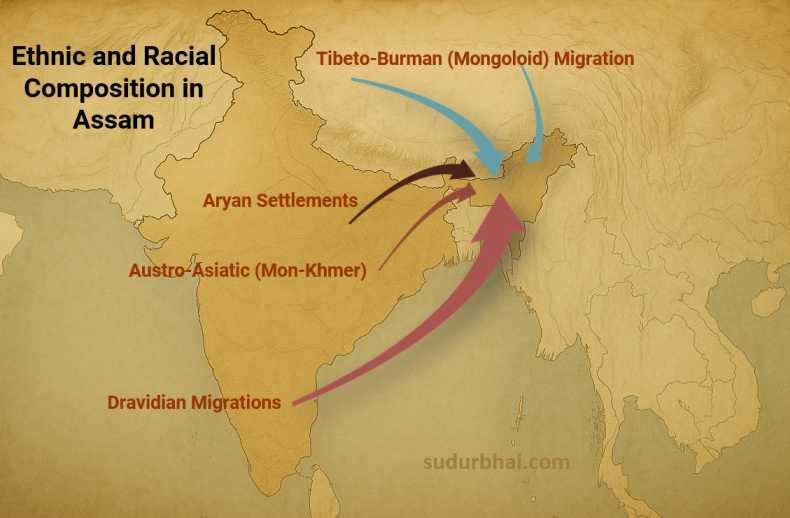Ethnic and Racial Composition in Assam
Assam’s ethnic makeup is the result of centuries of migrations, racial blending, and cultural assimilation. From Austric tribes to Dravidians, Mongoloids, and Aryans, each group contributed to shaping the region’s unique identity — forming the rich and composite Assamese culture seen today.
Austro-Asiatic (Mon-Khmer)
The earliest inhabitants of Assam were people of the Austro-Asiatic stock, particularly the Mon-Khmer language family.
These communities are believed to be the Neolithic aborigines of the region.
The present-day Khasis and Syntengs (Jaintias) of Meghalaya are considered their descendants.
Linguistically and culturally, they are closely related to the Mundas of Chotanagpur, establishing an ancient ethnic continuity.
Archaeological evidence, such as stone tools (celts), supports their presence across multiple sites in Assam.

Dravidian Migrations
The Dravidians represent a later wave of migration into Assam, arriving after the Austric groups.
They were part of the Chalcolithic Age and brought with them a refined culture, including early religious practices.
Lingam and Yoni worship, key elements of Dravidian spirituality, were later adopted by the Aryans.
The Kamakhya temple is cited as evidence of the antiquity of these fertility cults in Assam.
Over time, the Dravidians intermixed with Mongoloid migrants, leading to the creation of a hybrid racial group known as Mongolo-Dravidian.
Tibeto-Burman (Mongoloid) Migration
The Tibeto-Burmans, a Mongoloid racial group, migrated from Western China, particularly near the Yangtze and Hoang-Ho river basins.
These migrations possibly began around 2000 B.C., entering Assam through multiple routes.
This group constitutes the largest segment of Assam’s present-day indigenous population.
The Ahoms, who came in the 13th century, and later groups like the Khamtis, Phakials, Aitongs, and Turungs, also belong to this stock.
Linguistic Sub-Groups:
North Assam Group: Includes Adis, Nishis, Akas, Mishings, Mishimis (mostly Arunachali tribes).
Assam-Burmese Group: Includes Bodos, Nagas, Kuki-Chins.
The Bodo group is particularly large and includes tribes such as the Garos, Rabhas, Kacharis, Dimasas, Chutiyas, Morangs, Koches, Hajongs, Lalungs, etc.
In ancient Indian texts, many of these groups are referred to as Kiratas.
Aryan Settlements
The Aryans were among the last major ethnic groups to enter Assam.
According to S.K. Chatterjee, they arrived in North Bengal by around 700 B.C., from where they moved eastward into Assam.
Early Aryan settlement in Assam is linked with rulers like Naraka and Bhagadatta, as mentioned in the Kalika Purana.
Literary evidence from Ramayana, Mahabharata, and inscriptions of Bhaskaravarman confirm Aryan presence by the 5th century A.D..
The Aryan influence brought significant changes to language, religion, and social structure, gradually integrating local tribes into the wider Indic cultural framework.
Other Ethnic Elements (Irano-Scythians, Alpines)
Traces of Irano-Scythian and Alpine (Armenoid) racial elements have also been identified in Assam’s population.
However, the exact timeline and routes of migration of these groups remain uncertain.
Their presence points to Assam’s historic openness to multiple racial and cultural influences.
